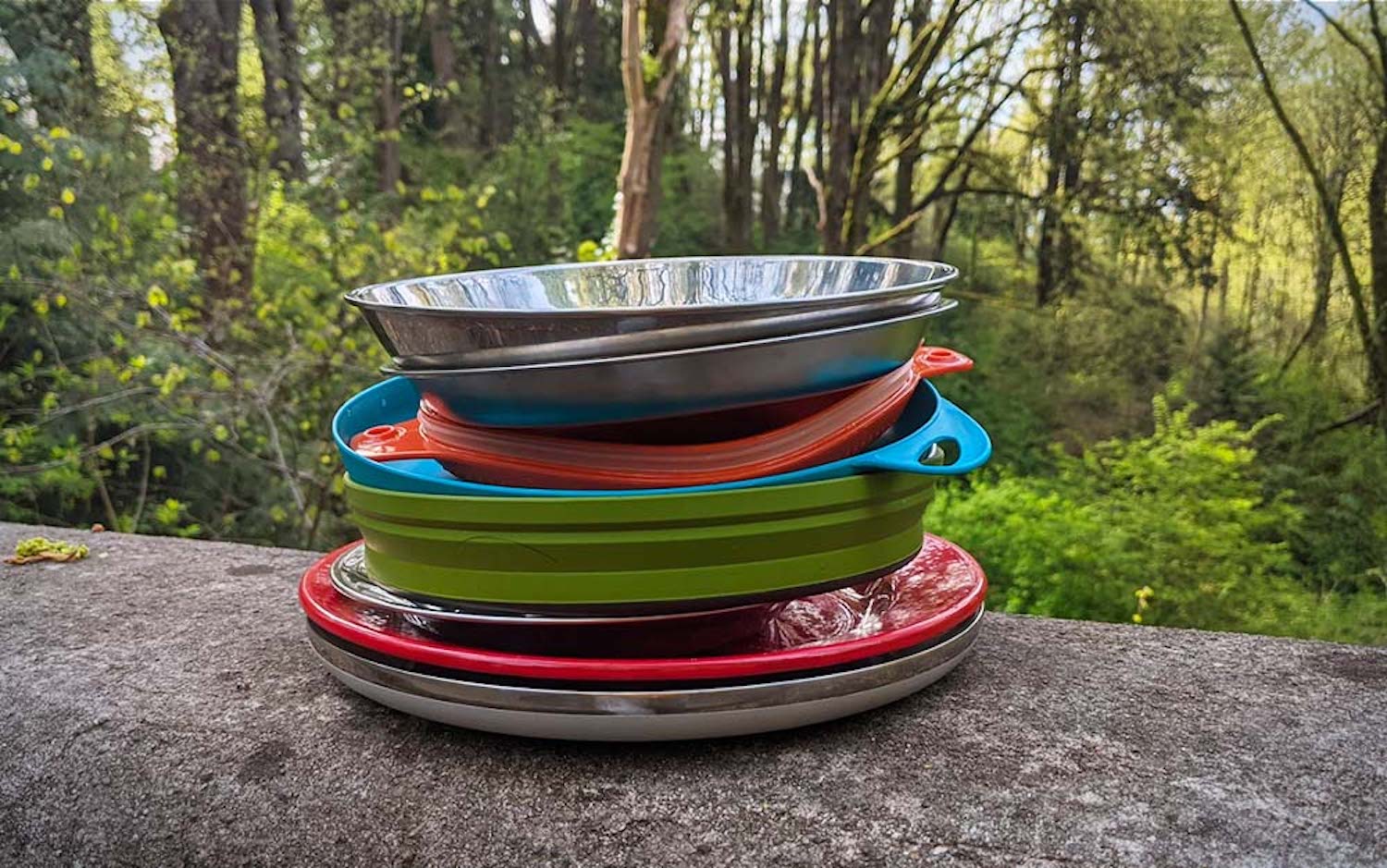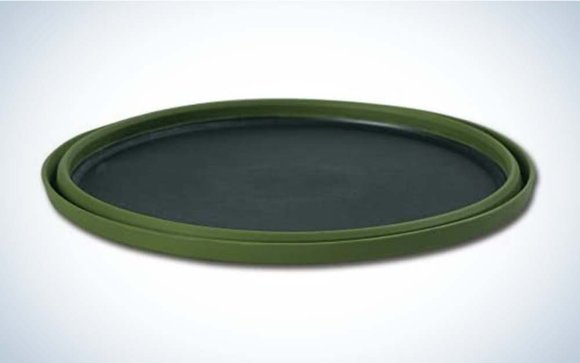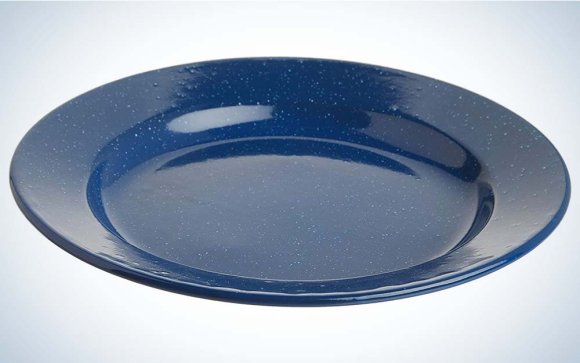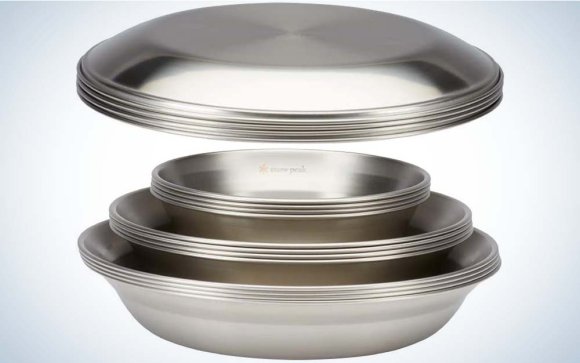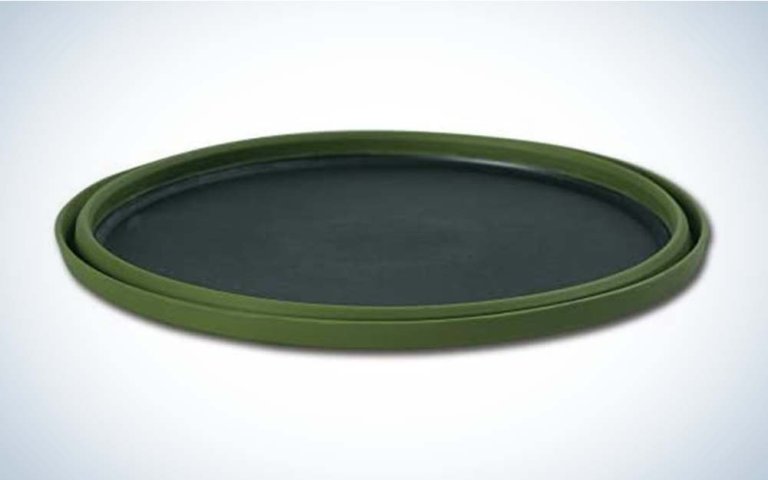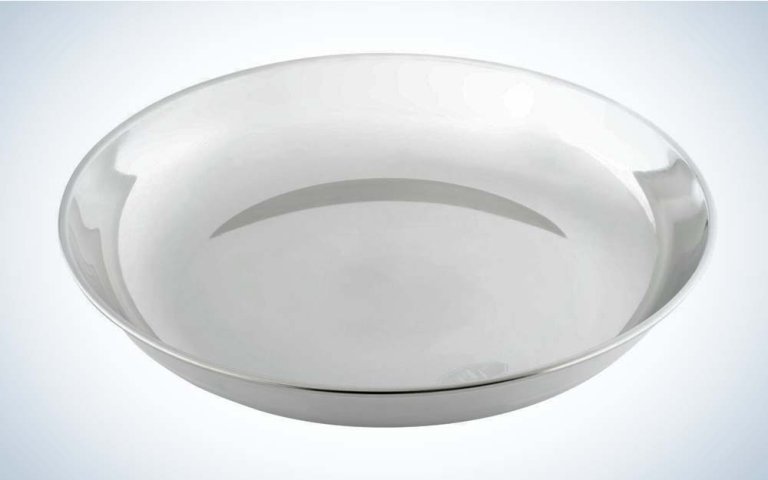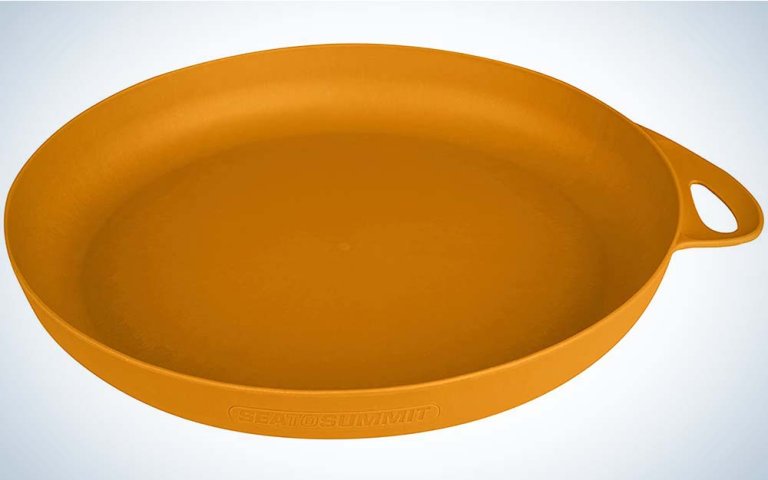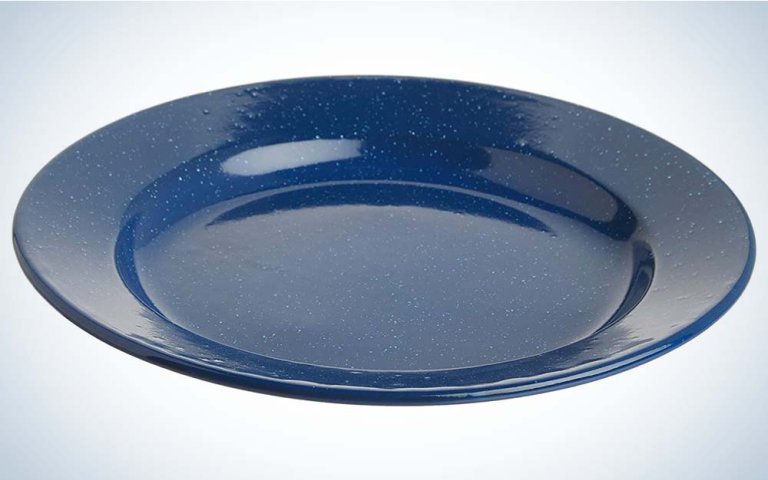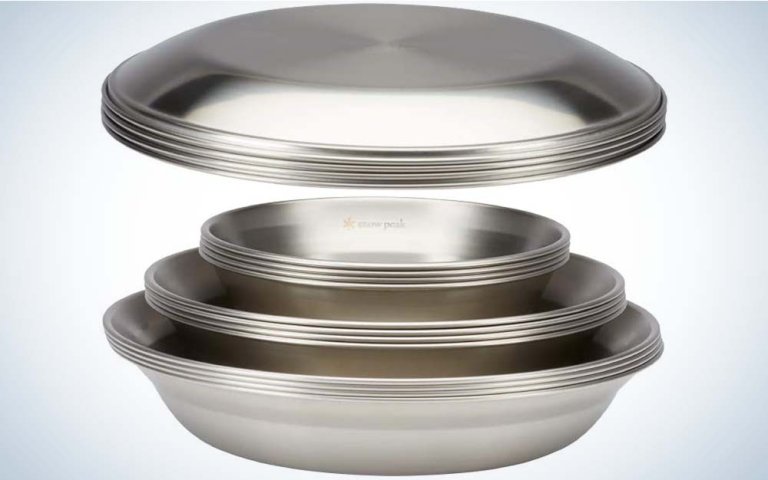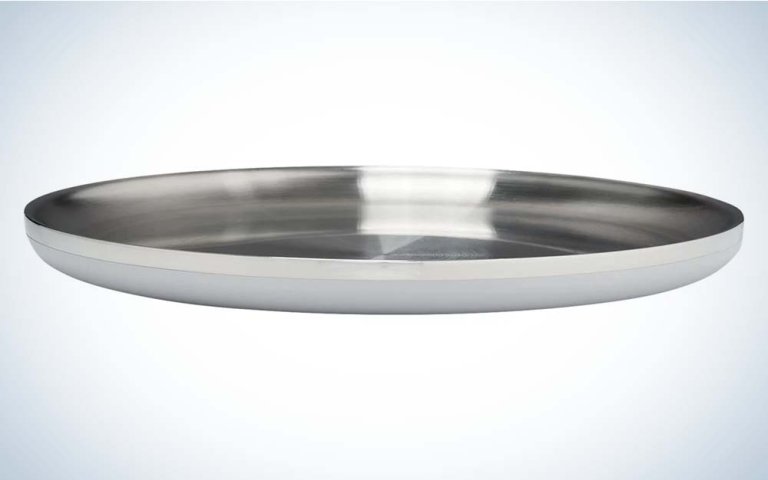We may earn revenue from the products available on this page and participate in affiliate programs. Learn More ›
Camping dishes, you ask? You mean those plastic-coated paper things you grab at the store while picking up a couple of bags of ice for the weekend? Yeah, those. There are a couple of reasons your paper plates need to go. First, they’re not great for the natural world you’re trying to enjoy. Also—given how many of those you’ve had to buy over the years—they really do end up costing more than the real deal. Finally, they just don’t work. They’re too flimsy to hold anything more substantial than potato chips. You pasta sauce spills over the sides. And that steak you just grilled over the campfire deserves a better presentation. To help you upgrade, I tested nine of the best camping dishes available and from that group selected the top six performers.
- Best Overall: Sea to Summit X-Plate
- Best Stainless Steel: GSI Glacier Stainless Deep Plate
- Best Plastic: Sea to Summit Delta Plate
- Best Budget: Coleman Enamelware Dinner Plate
- Best Set: Snow Peak Tableware Set
- Best Insulation: Hydro Flask Plate
How I Tested the Best Camping Dishes
To test the best camping dishes, I first compared the manufacturer weight and size specifications against my own measurements. I also measured the depth of each dish to better understand how it would work for saucy meals like pasta, or even soup.
Next I poured boiling water onto each camping dish, waited a few seconds, and then tried to pick it up. Some of the plates were comfortable to hold for long periods of time, while others were so scalding I had to set them back down. Next I tried to scratch each camping dish with a standard stainless steel fork, and then a butter knife.
Finally, I tested each option for durability. I took the camping dishes outside and threw them into the air, letting them fall on the pavement of the street (the “throw test”). Next I held a two-and-a-half-pound weight at shoulder height and dropped it on each camping dish (the “drop test”), aiming to hit both the center and the side, to mimic what would happen if something heavy was dropped onto a dish. I additionally took several of the camping dishes on a field test to ensure there weren’t additional factors that might impact performance on a camping or overlanding trip.
In the below table you’ll see a breakdown of how each camping dish performed in the testing categories. The MSR Alpine Plate, UCO 4-Piece Mess Kit, and Odoland Stainless Tableware Kit did not make the cut for my final best camping dishes list because they were not overly impressive in any category.

Best Camping Dishes: Reviews & Recommendations
Best Overall: Sea to Summit X-Plate
Pros
- Deep enough to hold saucy foods or even soup
- Surprisingly durable
- Insulates well
- Packs down small
Cons
- Nylon base is not scratch resistant
- Pricey
Key Features
- Manufacturer Size: 8 inches; measured size: 8.5 inches
- Manufacturer Weight: 5 ounces; measured weight: 6.2 ounces
- Materials: Silicone; nylon base
- Depth: 1.4 inches
- Dishwasher safe
The Sea to Summit X-Plate scored high in both durability and insulation, and it collapses down to an impressive half inch when it’s time to pack up, which made it the best overall. Whether it’s backpacking or camping, the last thing I want to worry about at the end of a long day outdoors is a plate. So the durability of the Sea to Summit X-Plate in both the throw test and the drop test excelled—if I squint, I can see a tiny scuff on its edge, but that’s it. I was also impressed at how well the X-Plate insulated my hand from heat during the boiling water test, which came in second overall.
But what makes the X-Plate unique is its collapsible sides. When they were up, the plate was almost one and a half inches deep, the highest of any we tested, but less than half an inch tall with the sides dropped down, which would be my preference for anything that needs a knife and fork. The collapsible sides also make it easier to pack into a camping box at the end of the day.
Best Stainless Steel: GSI Glacier Stainless Deep Plate
Pros
- Versatile enough for both soup and a knife and fork
- Can nest multiple plates together
- Withstood most scratching effectively
Cons
- Showed some denting after the drop test
Key Features
- Size: 8.5 inches
- Weight: 5.3 ounces
- Materials: stainless steel
- Depth: 1.4 inches
- Dishwasher safe
Stainless steel camping dishes are popular for good reason. They look great, and if you treat them well, they’ll last for years. The GSI Glacier passed the throw test with flying colors without any damage and suffered only minor denting from the drop test (which gave it a bit of a cool, rugged look). It showed no scratches when I used a fork on it and only a light scratch from a butter knife. Given that it’s just a thin sheet of stainless steel, I was surprised that it provided any insulation during the boiling water test. I wouldn’t hold it from the bottom with hot soup, but a glancing touch won’t singe your hand.
The depth of this plate makes it functional for a wide variety of backcountry meals, from soup to salads to steaks. And its curved design also means that it stacks well if you’re purchasing one for each member of the family.
Best Plastic: Sea to Summit Delta Plate
Pros
- Extremely durable
- Enough insulation from hot foods
- Lightweight enough for backpacking
Cons
- Doesn’t nest as well as others in the test
- Scratches easily
Key Features
- Manufacturer Size: 9 inches; measured size: 8.75 inches
- Manufacturer Weight: 4.6 ounces; measured weight: 4.3 ounces
- Materials: Polypropylene
- Depth: 1.1 inches
- Dishwasher safe
Great durability combined with solid insulation and BPA-free materials made the Sea to Summit Delta my favorite plastic camping dish. As someone who grew up eating off of scuffed-up, scratched plastic plates while car camping, I found that the Sea to Summit Delta really appealed to my nostalgia. Fortunately, it was much more durable than the plates of my youth and survived both the throw test and the drop test with only minor scuffs. The honeycomb pattern on the bottom gave it functional heat resistance—I wouldn’t want to hold this plate for a long time with hot soup in it but getting it from the camp kitchen to the table wouldn’t hurt.
I also liked its depth, which works well for salads and pastas, but it can also handle food that requires a knife and fork. This one did show scuffs from both a knife and fork, similar to other plastic plates. My only real complaint with the Delta is that it takes up more space in my camping box than others in this test.
Best Budget: Coleman Enamelware Dinner Plate
Pros
- Classic look elevates any camping meal
- One of the least expensive plates tested
- Scratch resistant
Cons
- Suffered significant scuffing and chipping during the throw and drop tests
- Lacks insulation from food heat
Key Features
- Size: 10 inches
- Weight: 11.5 ounces
- Materials: Alloy steel
- Depth: 0.4 inches
- Dishwasher safe
The Coleman enamel plates have solid functionality and a classic design at a great price. It’s hard to beat the classic speckled appearance of an enamel plate. Unlike the plastic and stainless steel plates I tested, the Coleman enamel plate did not have any scratches after I used both a fork and knife on it. While this camping dish did not bend or break during the throw and drop tests, significant chunks of the enamel came off. It could still be used for meals, but the appeal of its appearance disappeared. That said, the price and stackability of this camping plate make purchasing additional ones a reasonable option.
Best Set: Snow Peak Tableware Set
Pros
- Space efficient design
- Versatile dish sizes and shapes
- Plate is lightweight enough for backpacking
Cons
- Less durable than other stainless steel plates I tested
- Poor insulation from food heat
Key Features
- Size: 8.5 inches (for the plate)
- Weight: 4.7 ounces (for the plate); 15.5 ounces (for the set)
- Materials: Stainless steel
- Depth: 0.75 inches
- Dishwasher safe

An elegant, versatile design made the four pieces of this packable lightweight set a go-to in my camping box. If you enjoy creating elaborate, photo-worthy backcountry meals, a single plate or a single bowl can make this challenging. That’s why I love this Snow Peak tableware set—the four pieces range in size and shape from dinner plate to soup bowl and provide plenty of variety for anything you have in mind.
This set lacks durability. The plate bent on the throw test and had severe indents after the drop test. It also did a poor job of insulating my hand from boiling water (although this is less of an issue when you can stack a plate underneath a soup bowl). But these stacked well inside of the camping box, especially when there was more than one set stacked together, minimizing my concerns about long-term damage.
Best Insulation: Hydro Flask Plate
Pros
- Excellent insulation
- Rugged
Cons
- Not a space efficient choice
- Pricey
Key Features
- Size: 10 inches
- Manufacturer Weight: 1 pound, 9 ounces; measured weight: 1 pound, 8 ounces
- Materials: Stainless steel
- Depth: 0.75 inches
- Dishwasher safe
This plate had the best insulation I tested and a pleasing heft to it that handled the drop test better than most. Not only is the Hydro Flask Plate larger than any other camping dish I tested, at 0.86 inches high, it’s also larger than the ceramic plates I use at home. But if space isn’t an issue in your camping rig, there’s a lot to like here. First, it’s pretty dang durable. Only one small dent appeared at the side from the throw test (likely the weight of the plate itself was a factor here), and it came out of the tougher drop test almost completely unscathed. It also resisted scratching quite well. Only a single faint line showed after I used a knife on it.
The double-walled insulation (think of your camping mug) attributed to the heft of this plate, which provided excellent insulation. I could barely feel the heat from the boiling water on the sides of the plate and only a slightly unpleasant heat at the center. If you’re tired of treating burns after you singe your fingers whenever you pick up a thin stainless steel or titanium plate, this camping dish can help keep your fingers burn-free.
FAQs
Camping dishes can range from under $5 all the way up to $25 or more. While there are a ton of cheap options out there that aren’t worth the time, ones like the Coleman enamel dishes won’t break the bank but still work great.
If you’re on a budget, you can absolutely use whatever plates you have on hand (or find at a thrift store) for camping—I certainly did this myself more than once when I was younger. But if camping becomes a regular part of your outdoor adventuring, it’s worth the investment in a quality set of camping plates, as ceramic dishes are significantly more prone to breaking.
For long-term use, something that you could even pass down to your own kids one day, it’s hard to beat stainless steel camping dishes. It’s one of the toughest materials out there and, unlike titanium dishes, reasonably priced.

Things to Consider Before Buying Camping Dishes
Material
Camping dishes are made out of a number of different materials including stainless steel, plastic (such as melamine), enamel, silicone, and titanium. Different materials have different advantages and disadvantages—including price, durability, functionality, and aesthetic. For instance, stainless steel and titanium camping dishes are generally more durable than enamel or plastic, while enamel dishes show fewer scratches from a knife and fork than other materials.
Size
Overlanders, car campers, and RV campers may prefer larger camping dishes—something that can fit a steak and a couple of sides—while backpackers or backcountry hunters may want something lighter and more compact to go along with their backpacking food.
Shape
Unlike modern dinnerware sets, camping dishes come in a variety of heights, from nearly pancake flat to a borderline bowl. Several camping dishes that I looked at for this roundup straddled the distance between plate and bowl and worked equally well as either. The thickness of a plate also impacts how well it’s able to insulate your hand from the heat of your food.
Nesting
While it’s possible that you are looking to purchase a single camping dish, it’s more likely that you are looking to purchase dishes for multiple people. Nesting dishes are designed to fit neatly together, making them easier to stack and pack away in your camping box, especially if you have to pack other things like a camping stove or kettle.
Final Thoughts on the Best Camping Dishes
Choosing the best camping dishes for your cooking box is a small decision that can have a big affect on your quality of life. A number of options are available from manufacturers like Sea to Summit, MSR, Hydro Flask, Odoland, GSI, Coleman, Snow Peak, Wealers, and UCO. Pick the best one for your own camping style and space requirements, so you can focus on spending more time outdoors.
- Best Overall: Sea to Summit X-Plate
- Best Stainless Steel: GSI Glacier Stainless Deep Plate
- Best Plastic: Sea to Summit Delta Plate
- Best Budget: Coleman Enamelware Dinner Plate
- Best Set: Snow Peak Tableware Set
- Best Insulation: Hydro Flask Plate
